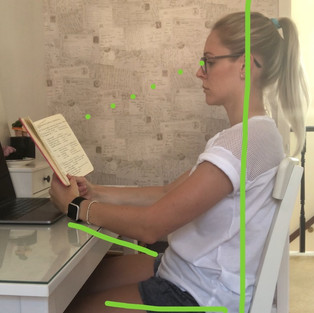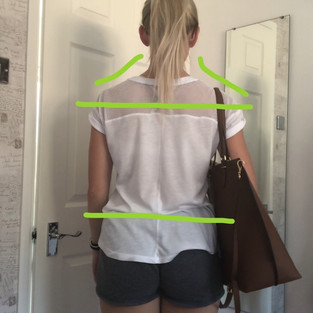POSTURE
- A J Robinson
- Jul 30, 2020
- 4 min read
Posture is defined as "the position in which someone holds their body when sitting or standing"... both of those things we do a lot of in everyday life. Some of us sit more than others depending on job role and physical activity levels throughout the day, but you may be wondering why I'm discussing it.
Our bodies can also be looked at as a "Human Movement System", or "the Kinetic Chain", which helps us to describe and understand human movements and the processes by which we move. Our body can be broken down into 6 main pieces; the trunk (our main mid-section of body), plus four limbs and the head, and further broken down into bones, joints, and muscles essentially. Each movement we perform can have an effect on another body part. If one section is misplaced slightly then we will soon notice problems in other body parts since the chain has been disturbed or has become disconnected. However, movement patterns will still continue and we find ways to deal with and complete daily tasks, even if it may have continued knock-on effects.
Most movements that we complete are repeated daily; sitting, standing, reading, sleeping, using technology and so on... What I'm asking you to consider is how well you hold yourself during these movements, and how many of them are done properly? Let's take sitting at a desk for an example, since many jobs are desk bound, and perhaps even more so now during lockdown - my job included for some of the day. Do you use a laptop, or desktop computer with keyboard and mouse? How supportive is your chair, and how well can you sit at a desk without slumping? How often do you stand up and stretch your legs, or roll your shoulders back to loosen up? Lastly, how many of us are culprits of chin poking - reading our computers, phones or books and suddenly realising that our chin is pushing further forward, away from the centre of our spine?
All of these positions can, and will more than likely, cause problems overtime to our posture (see the below photo diagrams of bad posture, and better posture when seated, reading or standing). Rounded shoulders whilst at the desk will cause tightness across the pectoral muscles (chest) and a possible weakness across the thoracic section of the spine (trapezius / rhomboids / scapulae - or upper back and shoulders). Slumping into the chair will likely cause the core musculature to become tight, and the lower back/ lumbar spine to become under-active. Sitting for long hours will tighten the hip flexors, and likely means the gluteals are also under-active. Lastly, chin poking to look down at a screen will mean the top of the cervical spine (back of the neck) may become weak over time and cause pain across the neck or upper back. Whilst standing, carrying heavy bags on one shoulder might cause an uneven slope; leaning more on one hip than the other may shorten or weaken the leg and core muscles on one side of the body more than the other.
Why is all of this a problem?
Muscles become tight, others become weak from inactivity; when done repetitively, our bodies will find ways to compensate and make up its own movement patterns, which could then in turn not only cause aches and pains, but also injuries. This will be noticed further when trying to do certain exercises - each bad movement that stems from. a poor movement pattern will reduce the efficiency of the kinetic chain and more work will therefore need to be done to help un-do our daily habits.
How can I change poor posture?
I understand you may not be completely ready to start a full-time gym plan, but there are still ways we can make changes to poor postural habits.If sitting down, ensure to sit a little straighter, and think about engaging the core (pull the navel away from your waistband). Roll the shoulders up, back and down, pulling the shoulder blades a little closer together. Pull the head back in line above the shoulders / spine. Try to avoid being seated for too long; walk around for a few minutes every hour (shoutout Apple Watches for the nudge!) Not only this, but consider the position of the computer you may be using, or the way your are holding your book, phone or tablet. Sometimes simply lifting or propping up the computer a little higher on your desk can help to automatically reduce the forward lean and chin poking since you're looking straight forward as opposed to down at an angle. A lot of bigger companies are quite good with this now, offering their employees an adjustable height desk and chair with back support and foot support. Some even offer standing desks to help employees keep moving a little more frequently throughout the day.
Maybe you don't work an office based job, but instead perform manual lifting and stand on your feet most of the day; this "office posture" isn't for you. It's still important to consider whether you are standing upright with core engaged and shoulders pulled back where possible, and if regularly manual lifting that you do so with correct technique so as not to strain any muscles.
Take some time to look at the regular movement patterns that you perform and decide if there's a more optimal way you could be moving. Personal Trainers should be able to look. at your movement patterns when you're training and help to balance out your posture with certain exercises and stretches. The most important thing to remember here is that there isn't likely to be a quick fix; 8 hours a day, 5 days a week sitting at a desk won't be fixed with one PT session a week, but when done properly it definitely can help. Persevere with exercises in your sessions, or try out classes that could help to improve movement patterns (particularly stretch classes, barre, yoga and pilates that work on lengthening of the muscles, and mobility around the joint). If you are desk bound then look at compound exercises to engage as many different muscles as possible, whilst manual jobs might look towards the importance of stability training and more individual muscle movements to improve strength in particular areas. Don't underestimate the power of posture... just get yourself moving!




















Comments